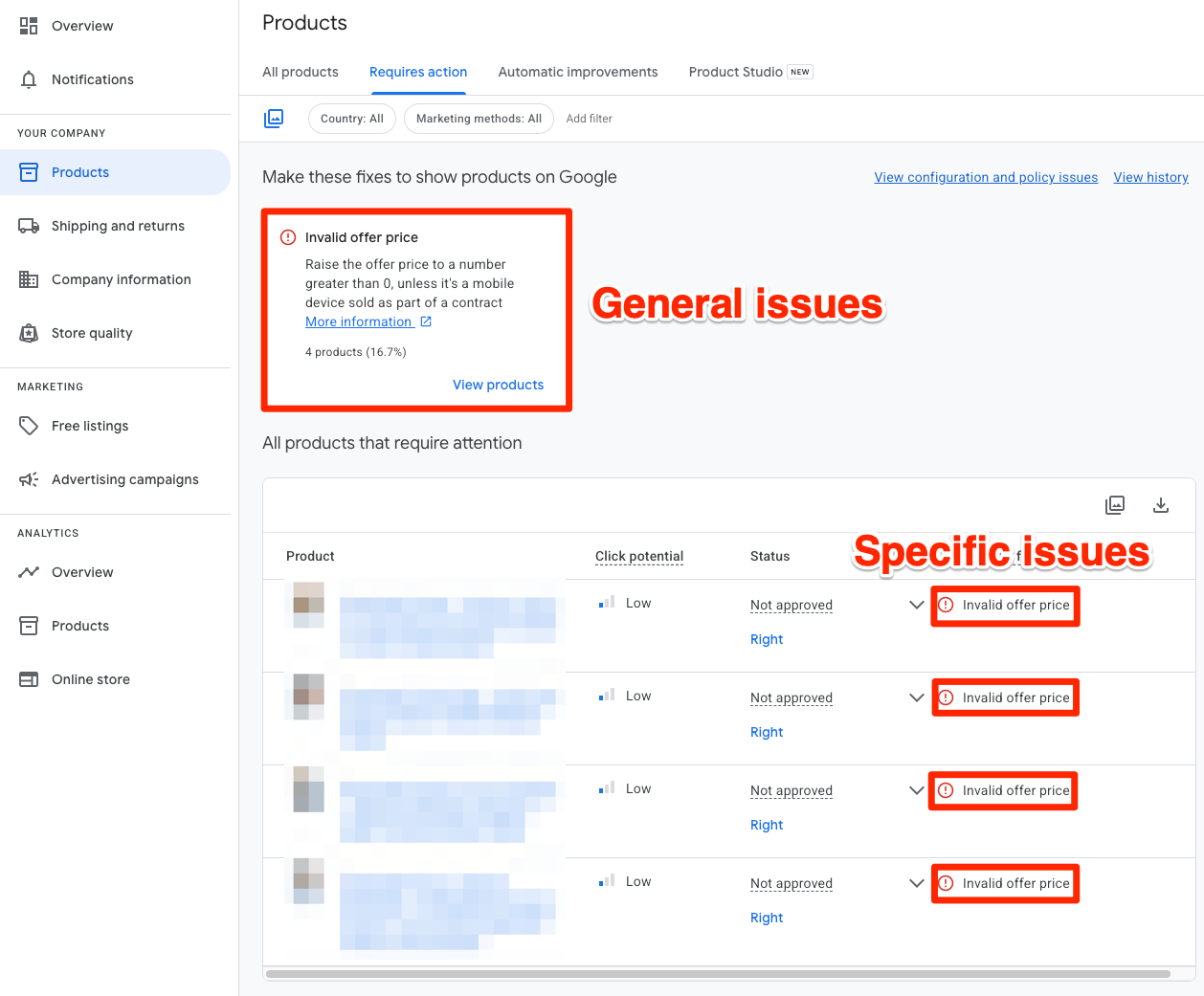Product disapprovals in Google Merchant Center can feel like a punch to the gut - especially when you’re counting on a sales surge and suddenly half your catalog vanishes from Shopping ads.
I’ve seen it happen to seasoned merchants and newcomers alike. The difference between those who recover quickly and those who spiral?
A clear, repeatable process for tackling disapprovals head-on.
Let’s break down a robust, field-tested approach to diagnosing, fixing, and preventing product disapprovals - so you can keep your listings live and your sales pipeline healthy.
The Hidden Impact of Disapprovals
Most merchants underestimate the ripple effect of a single product disapproval. It’s not just about one SKU missing from Google Shopping.
Disapprovals can quietly erode your entire campaign’s performance:
- Lost visibility: Disapproved products don’t show up in Shopping ads or search results. That means fewer eyeballs and fewer clicks.
- Revenue drain: If your bestsellers are disapproved, you’re handing sales to competitors.
- Feed quality score hit: Google tracks your feed health. Repeated issues can lower your ranking and make future approvals harder.
I’ve worked with businesses who let disapprovals linger for weeks, only to realize too late that their competitors had already scooped up their market share.
The lesson? Treat every disapproval as urgent.
Step-by-Step on How to Fix the Disapprovals
Years of managing feeds across multiple platforms taught me that chasing individual errors is a losing game.
Instead, I use a structured workflow that covers every angle.
1. Zero In on the Root Cause
Start with the facts. Open the Diagnostics tab in Merchant Center and ignore the urge to panic over big numbers. Instead, drill down:
- Click the number of disapproved products.
- Expand each error category to see which SKUs are affected.
- Read the specific error messages for each product.
A client once called me in a panic after their entire men’s jeans category disappeared. They assumed a catastrophic feed failure.
But a closer look at Diagnostics revealed every product was marked “Out of Stock” due to a botched inventory sync.
One fix to the availability field, and the products were back online within hours.
Never assume. The solution is almost always buried in the product-level details.

2. Address the Core Issues
Disapprovals usually fall into three buckets. Here’s how I tackle each:
Data Quality Problems
Google expects clean, complete data. The most common slip-ups I see:
- Missing GTIN, MPN, brand, color, or size
- Invalid or duplicate product identifiers
- Titles or descriptions stuffed with promo language
- Low-res, watermarked, or placeholder images
How I Fix It:
- Audit every required field—no blanks, no placeholders.
- Validate GTIN and MPN formats.
- Strip out any promotional text from titles and descriptions.
- Replace poor images with high-quality, compliant photos.
Policy Violations
Google’s policies are strict and always evolving. Common violations include:
- Promotional overlays (“50% OFF”) on images
- Prohibited or restricted products
- Exaggerated or misleading product claims
- Missing or unclear privacy and return policies on your site
How I Fix It:
- Remove all overlays and non-compliant content from images and descriptions.
- Double-check your website for visible, accessible policy pages.
- Stick to factual, accurate product descriptions.
Data Mismatch
Google cross-checks your feed against your website. If there’s a mismatch, expect a disapproval.
Classic Scenario: An electronics retailer listed a phone at $99 in the feed, but the site showed $119 due to a lag in updates.
Google flagged the mismatch and disapproved the SKU. After syncing the price and enabling automatic item updates, the issue disappeared.
How I Fix It:
- Enable automatic item updates in Merchant Center.
- Sync your feed daily with your inventory system.
- Regularly spot-check your site for price and availability accuracy.
3. Resubmit and Escalate When Needed
Once you’ve fixed the errors, it’s time to get your products back in the game:
- Resubmit your feed in Merchant Center (manual upload or automated fetch).
- For policy violations, request a manual review - Google doesn’t always auto-approve fixes.
- If you’re stuck in a loop of disapprovals, contact Google support directly. Sometimes a human review is the only way to clear up confusion.
A food retailer I worked with kept getting flagged for “Policy Violation” on a vegan snack bar. Google’s system misclassified it as a supplement.
After a manual review and a quick explanation, the product was approved.
4. Build Disapproval Prevention Into Your Workflow
Fixing disapprovals is good. Preventing them is better. Here’s how I keep my feeds clean:
- Weekly Diagnostics Checks: I review Merchant Center diagnostics every week—no exceptions.
- Feed Optimization Tools: Platforms like DataFeedWatch and Channable catch errors before they go live.
- Supplemental Feeds: For quick attribute fixes without touching your main ecommerce system.
- Policy Monitoring: I subscribe to Google’s policy updates and review changes regularly.
Issues & Solutions Table
This table is a bit easier to refer to when in trouble with disapprovals, use this to fix your specific case:
Automation is the Only Way to Scale
Manual checks are fine for a handful of products. But if you’re managing hundreds or thousands of SKUs, automation is non-negotiable.
My Toolkit:
- Feed Rules: Standardize brand names, strip unauthorized text, and fix recurring issues automatically.
- Automated Feed Platforms: Connect directly to your ecommerce backend. Any product update on your site is instantly reflected in your feed.
- Real-Time Updates: For fast-moving inventory or daily deals, real-time syncs keep your listings accurate.
A lighting retailer I worked with used to process feeds manually, which took hours and led to constant mismatches.
Once we switched to automated, incremental updates, their disapproval rate dropped to almost zero.
Common Pitfalls (and How to Dodge Them)
- Skipping Manual Reviews: Sometimes, only a human can resolve a stubborn disapproval.
- Ignoring Category-Specific Rules: Each product category has unique requirements. Always check the latest guidelines before listing new items.
- Not Testing Feed Changes: Run test feeds before rolling out major updates, especially for identifiers and pricing.
- Assuming the Problem Is Fixed: Always recheck Diagnostics after making changes. Don’t trust that a resubmitted feed is automatically clean.
Product disapprovals are a fact of life for anyone running Google Shopping campaigns.
But with a systematic approach - diagnose, correct, resubmit, and automate, you can keep your products visible, your ads running, and your revenue on track.
Don’t wait for the next wave of disapprovals to catch you off guard.
Build these steps into your routine, and you’ll spend less time firefighting and more time growing your business.
Frequently Asked Questions
Here we answered the most asked questions about product dissaprovals:
What causes product disapprovals in Google Merchant Center?
Product disapprovals usually stem from data quality issues (like missing GTINs or poor images), policy violations (such as prohibited content or misleading claims), or data mismatches between your feed and website (like price or availability differences).
How do I find out why my products were disapproved?
Head to the Diagnostics tab in Google Merchant Center. Drill down into the error categories and review the specific error messages for each affected SKU. The details are almost always at the product level.
What’s the fastest way to fix disapproved products?
Identify the root cause, correct the data or policy issue, and resubmit your feed. For policy violations, request a manual review if needed. If problems persist, contact Google support for clarification.
How can I prevent future disapprovals?
Schedule regular diagnostics checks, use feed optimization tools, keep up with Google’s policy updates, and automate your feed syncing to catch issues before they escalate.
What are the most common mistakes merchants make with disapprovals?
Skipping manual reviews, ignoring category-specific rules, not testing feed changes before going live, and assuming a resubmitted feed is automatically fixed are the most frequent pitfalls.
Is automation necessary for managing large product feeds?
Absolutely. Automation is essential for scaling—manual checks aren’t practical for hundreds or thousands of SKUs. Use feed rules, automated platforms, and real-time updates to keep your catalog compliant.
What should I do if my product is still disapproved after fixing the issue?
Request a manual review in Merchant Center. If that doesn’t resolve it, reach out to Google support directly. Sometimes only a human review can clear up persistent or unclear disapprovals.
How do data mismatches happen, and how can I avoid them?
Data mismatches occur when your feed doesn’t match your website’s price or availability. Avoid them by enabling automatic item updates, syncing your feed daily, and regularly spot-checking your site for accuracy.
Want to try the #1 AI Toolkit for SEO teams?
Our AI SEO assistants helps write and optimize everything - from descriptions and articles to product feeds - so they appeal to both customers and search engine algorithms. Try it now with a free trial→

![Product Disapprovals in Google Merchant Center [How to Fix Them]](https://cdn.prod.website-files.com/689da0db4875be384646a495/689dbebe3806a25460fedee5_Sebatian.png)
![Product Disapprovals in Google Merchant Center [How to Fix Them]](https://cdn.prod.website-files.com/689da0db4875be384646a495/68a46dda8d01677982031ce4_product-disapprovals-in-merchant-center.jpg)

